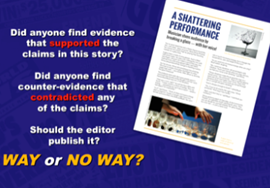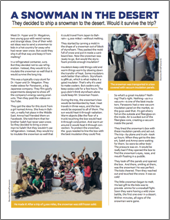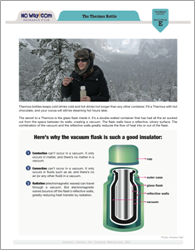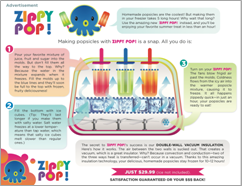In this activity, students become editors at NoWay!com, a website that publishes amazing-but-true stories. Two stories being considered for publication include claims about heat energy. Students must evaluate the validity of the claims by looking for relevant evidence in the informational resources provided. Based on what they find, they decide whether or not the site should publish the stories.
![]() This classroom activity, a central feature of our modules, offers a fun way for students to develop the critical thinking and science literacy skills emphasized in the Next Generation Science Standards—skills they’ll need in order to become critical consumers of scientific information and reporting. Moving away from the fantasy worlds of the video games, No Way! draws students into a compelling real-life scenario in which they are editorial interns at a science-themed website—NoWay!com.
This classroom activity, a central feature of our modules, offers a fun way for students to develop the critical thinking and science literacy skills emphasized in the Next Generation Science Standards—skills they’ll need in order to become critical consumers of scientific information and reporting. Moving away from the fantasy worlds of the video games, No Way! draws students into a compelling real-life scenario in which they are editorial interns at a science-themed website—NoWay!com.
 |
| After evaluating the claims in a story, students decide whether the site should publish it. |
The site publishes amazing-but-true stories about incredible natural phenomena, weird inventions, and sensational events. As part of the editorial team, students must investigate claims in articles being considered for publication on the site. The articles connect to the module’s content and focus on the misconception addressed in the video game. Playing No Way! gives students a chance to practice crucial argumentation skills while also deepening their understanding of the module’s topic.
The articles students evaluate were written specifically for No Way! Each contains several claims that need to be checked. The rule is that finding counterevidence for any claim means the story can’t be posted. The activity involves: a) looking for information relevant to a claim by referring to a set of reliable resources we provide; and b) determining whether the information they find constitutes evidence for or against the claim. While students will find evidence to corroborate most claims, the game keeps them focused on the search for counterevidence that invalidates a claim.
It takes 2–3 classes to complete the activity. Sessions end with students sharing what they’ve discovered and voting on whether a particular story should be published.
 |
| Students investigate the claims made in this story about transporting a snowman to the desert. |
In this activity, students are tasked with investigating an article and an ad that contain claims about heat energy, heat flow, and insulation. As with the related video game (Galactic Gloop Zoo), this activity provides an opportunity to help students understand how heat is transferred through conduction, convection, and radiation, and that heat moves from warmer to cooler substances.
After viewing the introductory slideshow, students turn their attention to “A Snowman in the Desert.” It’s the story of two young men who say that they transported a snowman from the mountains of Japan to the hot desert country of Bahrain, a journey of 5,000 miles. Their goal was to present it to children who had never seen snow, while also proving the effectiveness of vacuum insulation panels.
 |
| One of the resources students use to investigate claims about heat energy. |
The four claims in the story have to do with heat transfer and insulation. Working in small groups, students look for and record information relevant to the claims by going through a set of resources provided. Then they decide if the information constitutes evidence for or against each claim.
There is plenty of information in the resources to support the four claims, and none that serves as counterevidence that would invalidate any of the claims. If, based on their research, students decide that NoWay!com can post this article, they won’t be in danger of publishing something that contains a false science claim.
The advertisement being considered for NoWay!com is for a popsicle-maker called Zippy Pop! The students’ task is to determine if the infomercial-type ad is making any false claims about the product and how it works. To do that, they turn to the resources and look for relevant information that pertains to each claim in the ad. Then they must decide whether the evidence supports or disproves the claim.
 |
| Based on their evaluation of the ad’s claims, students decide whether the site should carry it. |
Students can find evidence to support three of the ad’s claims. But one claim in the ad reflects a misconception shared by many students about the directionality of heat flow—that “coldness” flows from a cold object into a warmer one, causing it to cool. In the resources, they can find accurate information about the directionality of heat flow that serves as counterevidence to that claim. The product could never work as advertised.
Since NoWay!com’s policy is to never use anything that contains a false claim, students will be making a wise and informed decision if they recommend that the site not carry the Zippy Pop! ad.
[Note: If this is the students’ first experience with No Way!, they should learn about the game’s premise and rules by viewing the Day 1 PowerPoint. It includes a guide to the claim-checking process they’ll be using as they go through the activity.]
We suggest spending three class periods on this activity. These are the materials you’ll need each day:
No Way! Activity: Heat Transfer DAY 1 Instructions
DAY 1 Slideshow (to show to the class)
“A Snowman in the Desert” Article (one copy per student)
Snowman Story: Finding Claims Worksheets
(one set per student)
No Way! Activity: Heat Transfer DAY 2 Instructions
DAY 2 Slideshow (to show to the class)
Snowman Story Resources
(one set for each group of four students)
Snowman Story: Checking Claims Worksheets
(two sets for each group of four students)
“Zippy Pop!” Ad (one copy per student)
Zippy Pop! Ad: Finding Claims Worksheets
(one set per student)
No Way! Activity: Heat Transfer DAY 3 Instructions
DAY 3 Slideshow (to show to the class)
Zippy Pop! Ad Resources
(one set for each group of four students)
Zippy Pop! Ad: Checking Claims Worksheets
(two sets for each group of four students)
The No Way! critical thinking activity connects to Practice 7: Engaging in Argument from Evidence. It offers students opportunities to evaluate and critique scientifically based arguments in the media, an ability emphasized in the NGSS description of Practice 7: “The scientist and the citizen alike must make evaluative judgments about the validity of science-related media reports and their implications for people’s own lives and society. Becoming a critical consumer of science is fostered by opportunities to use critique and evaluation to judge the merits of any scientifically based argument.”
No Way! directly addresses two specific goals of Practice 7: Engaging in Argument from Evidence:
No Way! connects to CCR Reading Anchor #8, which emphasizes evaluating the validity of arguments and whether the evidence offered backs up the claims logically. ( CCR Reading Anchor #8: Delineate and evaluate the argument and specific claims in a text, including the validity of the reasoning as well as the relevance and sufficiency of the evidence.)